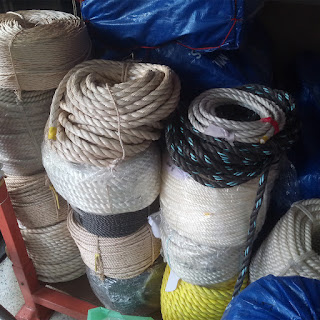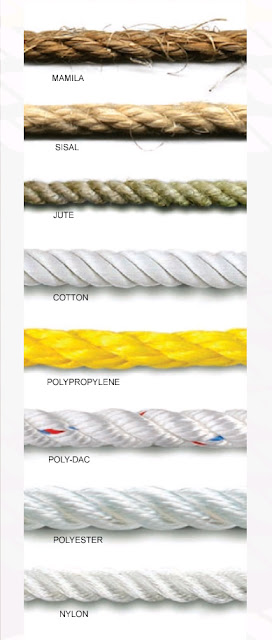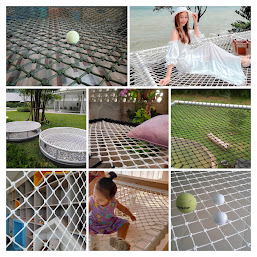S
election guide to help you decide which kind of rope is right for your application
 |
| เชือก ชนิดเชือก |
 |
| ชนิดของเชื่อก |
- MANILA was once the preferred choice in cordage before synthetic fibers were developed. Manila rope still maintains some advantages to synthetic fiber rope; it is not affected by heat, and has excellent resistance to UV (ultraviolet) rays.
- SISAL fibers come from the agave and sisalana plants indigenous to the tropics.
Sisal fibers share many characteristics with manila, but only 80% of its tensile strength. It is less expensive than manila and makes a good general purpose rope. Sisal is commonly used to produce tying twine as well.
- JUTE is mainly used as a tying twine. It knots well, but due to its short fibers, does not have the strength of manila or sisal.
- COTTON is a natural fiber, typically white in color. Cotton cordage is soft, making it pleasant to handle. It also knots very well.
- POLYPROPYLENE rope is flexible and lightweight. It is rot-proof and floats in water; it resists oil, water, gasoline and most chemicals. Available twisted or braided, polypropylene rope is an economical general purpose rope.
- POLY-DAC is polyester strands wrapped around polypropylene core yarns. This rope exhibits the same qualities as polypropylene, with good abrasion resistance, relatively low stretch, and better resistance to UV rays.
- POLYESTER is very strong and has excellent resistance to abrasion. It stretches much less than nylon, but does not absorb shock like nylon; this makes polyester very popular for marine or industrial applications, where stretch is not desired. It is resistant to UV rays, rot, petroleum products and most chemicals.
- NYLON is known for its elasticity and tremendous shock absorbing qualities. It has good abrasion resistance, is rot proof and resists petroleum products and most chemicals. It is resistant to UV rays. Nylon rope will last 4-5 times longer than ropes made of natural fibers.
Characteristic Comparison Table
| FIBER TYPE |
NYLON |
POLYESTER |
POLYPROPYLENE |
POLY-DAC |
MANILA / SISAL |
COTTON |
| WET STRENGTH VS DRY STRENGTH |
1 |
2 |
3 |
4 |
5 |
6 |
| SHOCK LOAD ABILITY |
85% |
100% |
100% |
100% |
115% |
115% |
| FLOATS OR SINKS IN WATER |
SINKS |
SINKS |
FLOATS |
FLOATS |
SINKS |
SINKS |
| ELONGATION AT BREAK |
20%-34% |
15%-20% |
15%-20% |
10%-15% |
10%-15% |
5%-10% |
| WATER ABSORPTION |
6% |
ZERO |
ZERO |
ZERO |
100% |
100% |
| MELTING POINT |
480°F |
500°F |
330°F |
275°F |
DOES NOT MELT CHARS AT 350°F |
DOES NOT MELT CHARS AT 350°F |
| ABRASION RESISTANCE |
2 |
1 |
4 |
5 |
3 |
3 |
| RESISTANCE TO SUNLIGHT |
GOOD |
EXECELLENT |
POOR |
FAIR |
GOOD |
GOOD |
| RESISTANCE TO ROT |
EXECELLENT |
EXECELLENT |
EXECELLENT |
EXECELLENT |
POOR |
POOR |
| RESISTANCE TO ACIDS |
POOR |
GOOD |
GOOD |
GOOD |
POOR |
POOR |
| RESISTANCE TO ALKALIS |
GOOD |
POOR |
GOOD |
GOOD |
POOR |
POOR |
| RESISTANCE TO OIL AND GAS |
GOOD |
GOOD |
GOOD |
GOOD |
POOR |
POOR |
| ELECTRICAL CONDUCTIVITTY RESISTANCE |
POOR |
GOOD |
GOOD |
GOOD |
POOR |
POOR |
| FLEXING ENDURANCE |
1 |
2 |
3 |
6 |
4 |
5 |
| SPECIFIC GRAVITY |
1.14 |
1.38 |
.90 |
.95 |
1.38 |
1.54 |
| STORAGE REQUIREMENTS |
WET OR DRY |
WET OR DRY |
WET OR DRY |
WET OR DRY |
DRY ONLY |
DRY ONLY |



 RopeNets Lifestyles
RopeNets Lifestyles

